As your company grows, there's a lot of questions and challenges you have to answer:
- What defines your culture?
- How will you hit your growth targets?
- What will the org chart look like?
- How do you celebrate wins and handle losses?
- What will you do to manage expectations inside and out of the company?
What you decide to do for one of these questions can affect many of the others.
One of the most far-reaching and impactful choices you make is whether you promote from within, or hire talent from outside. While sometimes, a role requires a veteran from outside, there are many benefits to promoting from within as much as you can.
Today, we look at the reasons you should try to promote from within whenever possible.
Table of Contents: Why You Should Promote from Within & How You Can Do It Well
If you've ever asked, "why should we promote you" as a team a leader, this post will help you understand the case for looking internally for key hires as you build your organization.
- Why You Should Promote from Within at Your Company
- Strengthens your company's culture
- Rewards loyalty
- Keeps institutional knowledge
- Rewards the behaviors you want to see on your team
- How to Successfully Promote from Within
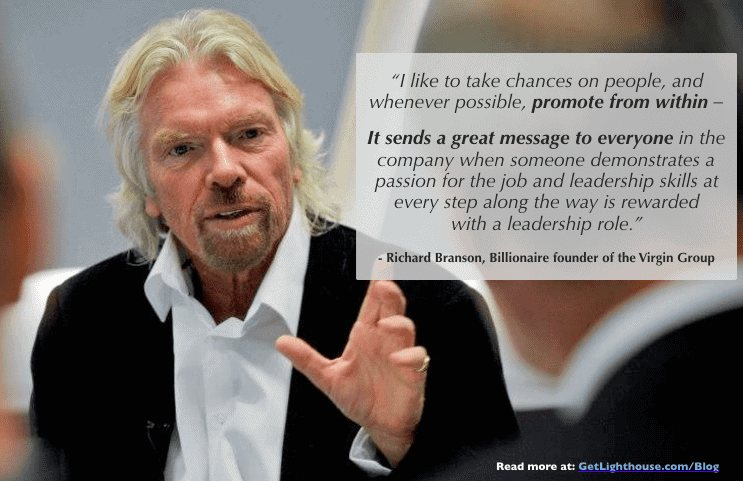
Why You Should Promote from Within at Your Company
Put simply, hiring outside tends to fail. A workplace study by Wharton management Professor Matthew Bidwell found that "external hires" have a tendency to be the worst of all worlds for companies that go that route:
- External hires tend to get, "significantly lower performance evaluations for their first two years on the job than do internal workers who are promoted into similar jobs."
- They also have, "higher exit rates, and they are paid about 18% to 20% more"
Are you excited to pay more for lower performance? Unlikely.
Here's a few great reasons why the Wharton study likely came out this way.
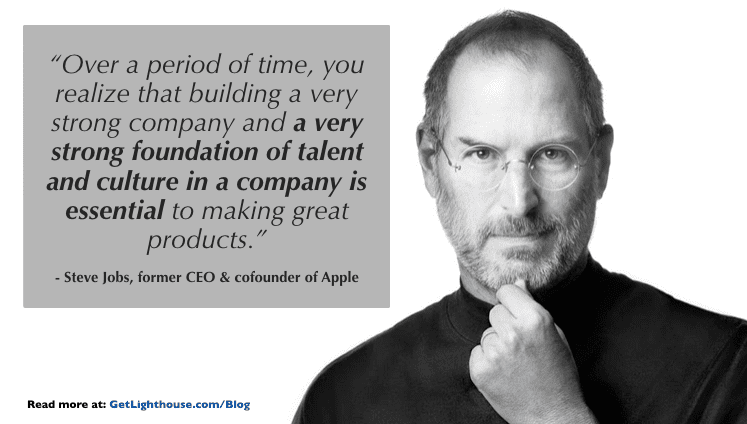
1) Strengthen your company's culture
The longer you can retain your best people, the stronger your culture will be.
Long-time leaders can help be better hiring filters to maintain your early culture's feel long after the "small team in a garage" stage is passed.
Who you choose to hire as you grow matters a lot, and at some point, founders are not going to be able to filter everyone themselves. Having people you have trusted for a long time be part of those decisions instead can help ease your mind and scale culture fit decisions.
Create smooth transitions.
When you promote someone who was already in your company, much of the transition can be a lot smoother:
- Familiarity: The new leader already knows how to get things done in your company.
- Rapport: They have many existing relationships within the company and especially their team.
- Mobility: It creates an opening behind them for someone else to move into as well.
Think about how that works versus bringing in an outsider:
- Starting Cold: An external hire has to build fresh relationships, slowing you down until they build them (or permanently if they do not).
- Culture Shock: They can bring a culture to their team that clashes with what the team is used to.
- Blocked: Hiring in means everyone below them in the org chart stays where they are.
This does not mean all external hires are doomed to fail. However, it does mean that it's harder to get it right. The Wharton study referenced above found that external hires that lasted over 2 years thrived.
The example you set is the most important part of developing a strong culture at your company or on your team. As Jobs and Branson describe above, promoting from within is a great way to preserve your culture as you grow.
Further Reading: Who you choose to promote is a critical decision. These links can help you navigate the challenging process:
- How to develop leaders in your organization when your team gets too big
- How to manage former peers

2) Reward loyalty
You want your best employees to stick around, right? Show them that working hard pays off.
Study after study after study from the likes of PwC, Gallup, Deloitte, and Google all show that employees want growth and development. This often becomes an issue as early as 25 employees.
When you promote from within, you're showing your people that if they stick around, do a good job and work hard, they can be rewarded.
"Loyalty up and loyalty down."
A lot of founders I talk to demand loyalty from their people only one way. They're hurt when they see people leave or take other actions they view as "disloyal." Unfortunately, they often forget what Rear Adm. Grace Hopper aptly calls, "Loyalty down."
When you recognize people for their loyalty and demonstrate your loyalty to them, you keep your part of the social contract as their employer.
Regular moments of praise and appreciation can go a long way, but at times, you'll need to make larger gestures to keep your best people. When you promote from within, you're making an essential, significant gesture.
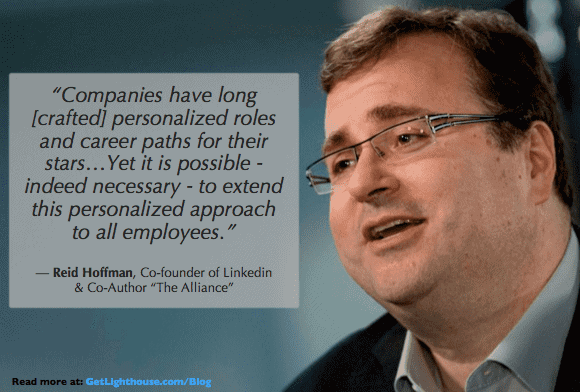
Demonstrate there are growth paths.
Showing your people you have faith in them to tackle new challenges is a great win-win in the loyalty department.
For your employees, they get a new challenge and opportunity to prove themselves again, growing within the workplace they've grown to love. For executive leadership, this gives you a way to show everyone what matters and what you want to see more of.
Or put more simply by the former founder and CEO of Intel, Andy Grove:
"By elevating someone, we are, in effect, creating role models for others in our organization."
How are you rewarding your most loyal people? Who are the role models you're choosing for your company? These are questions you should take time to deeply reflect on, and create good answers.
Further Reading: If you decide to reward the loyalty from some of your team with promotions, keep these pitfalls in mind:
- How to deal with a manager who doesn't manage.
- How to help your new, inexperienced managers succeed.
- 10 common mistakes companies make when promoting from within (and how to avoid them).
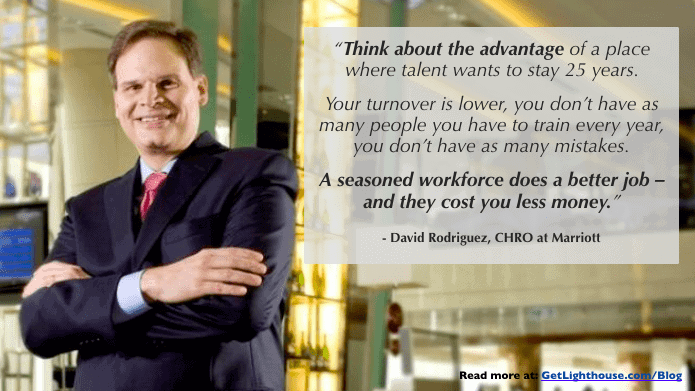
3) Keep institutional knowledge
Beyond preserving your culture and growing your people, when you promote from within you ensure key company knowledge sticks around.
Your long-time, loyal staff are keepers of your company mythology; they experienced first-hand how you've handled challenges in the past, and remember situations that may have happened years ago that are key to what your company will and will not do now.
This allows for faster, better decisions you can trust.
Can you expect the same from brand new hires? Unlikely, unless they have someone to guide them who has been around.
The true value of retention.
If there's no path for them to grow, or external leaders come in and mess up the culture of their team, you will lose good people. Walking out the door with them will be all kinds of valuable knowledge. That's why David Rodriguez, CHRO of Marriott, is so bullish on the value of retaining your workforce long-term.
It's also how Maia Josebachvili of Greenhouse calculated a stunning value for keeping your best people around for the long haul:
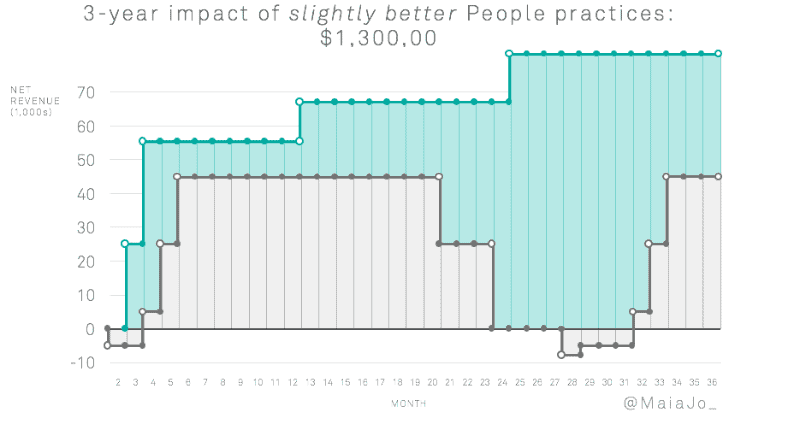
There's many key people practices she highlights leading to this difference. One of the most important ones is good management and a strong culture. Hiring and promoting the right leaders is a huge part of that.
There are so many reasons people leave managers, not companies. If you promote from within, and give them the right support, good people are much more likely to stay. This then creates a virtuous cycle of value for your company:
- Retained: Good people are motivated to stay, saving you money and time on recruiting and retraining.
- Improved Asset: As they grow, they become more and more valuable to the company due to their experience and skill depth.
- Rising Tide: When you promote from within, openings cascade open behind them as others can rise behind them.
This process can then repeat itself again and again to further strengthen your culture and reduce costs. Meanwhile, the knowledge you lose when employees quit hurts your culture, and the skills of the team they're on.
Further Reading: Are you thinking more about the value of good managers, the cost of turnover, or how to better tap into the knowledge you have in your organization? Here's a few places to start:
- Why a good manager is worth $192,000 more than a bad manager every year.
- Why replacing a single employee can cost you over $65,500.
- Use these 150+ questions to open up your 1 on 1s to tap into the knowledge in your team you never get around to discussing.
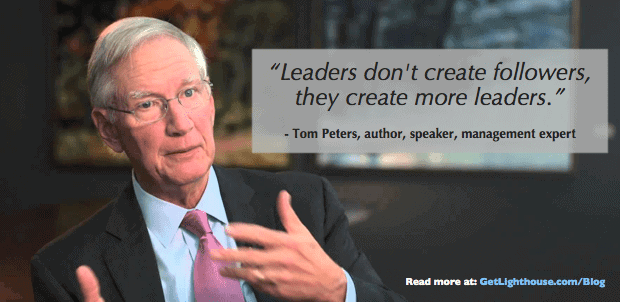
4) Reward what you want to see more of
Promoting from within is also important because it shows your team the traits you want to see more of. These qualities represent a blueprint for all future leaders on your team and something people can strive toward.
On the other hand, when you hire externally, it may not be clear to your team members why you made your choice.
Even worse, you could be signaling to them they don’t possess the qualities you’re looking for and discouraging them in the long term. Think about what option makes more sense:
- Nurturing the qualities you want to see on your team and being clear about what you expect from managers, possibly shaping an entire future generation of leaders
or
- Taking a bet on someone new without telling your team what motivated your decision, risking making people feel insecure and diluting your company culture
This question puts into perspective just how important promoting from within is for your company.
Culture is like concrete
Culture is like concrete, so the more you promote from within, the more you establish key cultural values that you want to reward. This is an idea Joe Gebbia, the co-founder of Airbnb, learned from Tony Hsieh:
When it is first laid out, culture can take many shapes until it hardens. However, after some time, it will harden and then it's very hard to change.
If you haven’t developed a clear vision of what traits you want to see on your team and why, you could experience negative consequences in the form of higher turnover. Or, you’ll wake up with a culture you don’t want and find it difficult to change.
In fact, a Columbia University study has shown that the likelihood of turnover at an organization with an intentional approach to building its company culture is a mere 13.9 percent. On the other hand, the probability of turnover in companies that don't put a lot of thought and effort into their culture can be as much as 48.4 percent.
Choose the qualities you want to see on your team carefully. Once you do, be very intentional about instilling them in your team members and rewarding the behaviors you want to see by promoting the right people to roles that require those values and skills.
Further reading: If you want more tips on creating a great company culture, check out these posts:
- 5 Ways Founders Wreck Their Company Culture (and How to Create a Great Company Culture)
- The Truth About Creating Great Corporate Culture
- 6 Questions to Ask a CEO to Ensure a Healthy Company Culture
- Why Silicon Valley has so many Bad Managers
The Bottom Line: Promoting from Within Wins
We know this is a lot of information on why promoting from within is so valuable for companies. Let's recap the key differences between internal promotion and external hiring:
| Aspects | Promoting from within | External Hiring |
| Culture Fit | Certain - You already know them, so you know they’re a fit. | Risky — it’s hard to tell if they’ll fit and you won’t know until after you hire them. |
| Institutional Knowledge Retained | Retained — Build on their existing knowledge | Lost — a new hire starts from scratch learning processes and how you do things |
| Transition | Smooth — they can leverage existing relationships and build on their prior role | Rockier — they will be starting from scratch and their team may resent not having gotten the role |
| Cost | Lower — may be able to have them grow into full compensation. Can be as great as 18%-20% lower expenses. | Higher — must pay market or higher rates to attract talent and convince them to join. |
| Retention Rates | Higher — more employees will stay when they see clear paths for growth and advancement at your company. | Lower — if your employees see no way to advance, they may leave, and data shows external hires work out less often. |
| Ramp Up Time | Faster — knows systems already | Slower — brand new learning curve with no prior knowledge or connections to your company. |
As you can see, promoting from within comes out ahead in almost every category. The culture fit, knowledge retention, faster transition, and improved retention rates make going with an internal candidate the lower risk option in most cases.
Sure, sometimes you need fresh perspectives from external hires. Diversity of thought prevents groupthink. But when you have qualified internal candidates, promoting from within should be your first choice.
However, there is still something more that you need to know if you decide to go this path.
How to Successfully Promote from Within
Promoting from within sounds great in theory and as you have seen, it brings a lot of benefits over the external hires.
Nevertheless, you should know that it can get messy in practice if you don't have a plan and haven’t done it before. No one wants to have to demote someone who you thought would be great in a new role. That means now is the time to talk about how to run a smooth internal promotion process and avoid any problems that may come after this decision.
Set Clear Criteria
First, determine what qualities, skills, and experience you want for the new role. Be specific.
If you are looking for something generic, like “A teammate with high potential to manage a team,” then you may be disappointed with the results you get. Be specific on the skills and traits they need to succeed. Then, from the start of any conversation, share those requirements openly, so that employees can self-assess if they're a fit, and will know how you’ll evaluate them.
We understand that if you are doing this for the first time, then it may be a little difficult to come up with them. To help you, here’s a good example of some key qualities to look for if you are hiring for a management role:
- Shows empathy for others
- Be a good listener
- Consistent and accountable
- Interested in the life of a leader
- Committed to learning and growth
You can learn more about these qualities of a good leader in our post.
Open Applications Wide
Allow all qualified internal candidates to apply, not just who you have in mind. This reduces unconscious bias in hiring and builds trust in the process. You never know who might surprise you with interest, and it prevents you from choosing the first person you think of.
Opening the job to all qualified internal applicants also makes the process more fair and merit-based. It surfaces talented people you may not have considered otherwise, and it shows employees their hard work could be rewarded with advancement opportunities.
Interview Thoroughly
Take all candidates through the full interview process, just like an external hire. Conduct skills assessments, behavioral interviews, and reference checks. Look out for red flags that they may not be ready. You definitely don’t want to end up in a situation where you promoted the wrong person, as this won’t bring anything good to the company and you.
Best of all, this is a great time investment for your team; while an external candidate who doesn’t work out ends up feeling like lost time, an internal candidate can get a lot of value from the process. Often, your team members will see that they don’t have the skills they need yet, and you can transition the conversation to a great growth plan for them to be ready when a similar role opens again. That’s how great leaders create win-wins.
Train for Success
We can't emphasize enough how important training is for newly promoted managers. Even your top performer will need help transitioning to leadership, especially if this is their first leadership position.
That means you shouldn’t just throw them in the deep end. That’s unfair to them, and will ultimately reflect back poorly on you, because the assumption then will be either you chose poorly or didn’t help them succeed.
Instead, work with them to identify skill gaps and provide access to courses or coaches to develop those capabilities quickly. Schedule dedicated time in their calendar for coaching them (your 1 on 1s with them is the perfect time). Things like empathy, influence skills, time management, and communication need focus and practice to master.
There are countless managers who struggle because they didn't get the development they needed. Be proactive and give your new leader support from Day 1. They'll gain confidence and avoid feeling overwhelmed.
Need help figuring out what training to provide? Check out our post on how to help your manager succeed. The time you invest here pays back tenfold in their future success.
Celebrate the Big Win
Promoting from within is a good reason to celebrate and praise someone. You don’t need to organize a big party on a yacht, but announcing the promotion publicly and perhaps a team lunch or drinks would be a great way to recognize the moment.
A public announcement that someone has been promoted is good for a few reasons:
- The event can serve as a key marker. If a former peer is now the leader of a team, the event can clearly mark the transition for them. This makes it clear they have new responsibilities and authority, which you’re granting them and endorsing.
- It provides praise and incentive. For the employee promoted, it’s a great reward and recognition of their efforts paying off. For others, it shows them what they should aspire to. As the leader doing the promotion, it’s a good idea to call out exactly what those qualities are so everyone knows what was specifically rewarded here.
- It may be not that obvious, but when you promote someone, you share a little piece of your own authority with that person. Public recognition is one of the ways to do it and show to other teammates that you trust the new manager. They need to see that you are confident in your decision.
Help your team understand what a good answer is when they ask themselves, "Why should I be promoted?"
Now, when you promote from within, your work is just beginning. None of this works if you don't have a culture of developing leaders.
It's a major career change to become a manager, and every step up in an organization presents significant new challenges.
If you're not careful, it's easy for the Peter Principle to derail your organization by filling it with people in over their heads. No one likes to work for a boss who doesn't know what they're doing.
That's why if you're going to promote from within, you have to invest significantly in training and developing your people. Without help, you have to bet on how well they will self-teach, and have no standard approach to leadership in your company.
But how do you do that? There's two key ways:
- Understand what the difference is between success and failure of promoting from within. Learn the 10 most common mistakes when promoting from within (and what to do about them) here.
- Set a good example, have awesome skip level 1 on 1s to learn how your managers are doing, and give your new managers an easy to follow leadership framework.
Want to build up your management skills? Lighthouse Lessons can help you.
Our bite size, highly actionable programs are perfect for even the busiest of managers. Become a better leader like Jonathan Silva did by learning more and signing up here.





